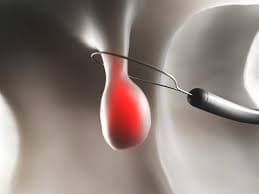The gallbladder is a sac-like organ in the body where bile is stored. Bile, produced in the liver, travels to the gallbladder for storage before moving into the intestine. It plays a key role in the digestion of fats. The salts, lipids, pigments, and cholesterol in bile reach the first part of the small intestine, aiding in the breakdown of dietary fats.
A variety of issues can affect the gallbladder. One such problem is gallbladder polyps, which occur when epithelial cells grow abnormally and create a protrusion. Although these polyps typically appear in the gallbladder, similar growths can also develop in the colon and other locations.
Types and Characteristics of Gallbladder Polyps
Those asking “What are gallbladder polyps?” typically want comprehensive information about these growths. Gallbladder polyps are tissue overgrowths within the gallbladder’s inner lining. They can vary in size and shape—some attach to the gallbladder wall with a stalk, whereas others do not.
A key concern is whether “Gallbladder polyps are harmful.” Some polyps arise from certain diseases, while others can become inflamed or even progress to cancer. Research shows that approximately 5% of gallbladder polyps may transform into cancer, with the likelihood increasing as the polyp grows larger. The risk also depends on the type of polyp:
- Pseudopolyps: These benign polyps arise from cholesterol lipids.
- Inflammatory polyps: These develop due to inflammation in the gallbladder.
- Adenomyomatosis: This refers to overgrowth in the gallbladder lining.
- Adenomas: Another type of benign polyp, with a low chance of malignancy.
- Malignant polyps: The most dangerous. They can lead to a type of cancer called adenocarcinoma.
Symptoms of Gallbladder Polyps
Gallbladder polyps sometimes present no symptoms. Problems can occur if they cause blockage in the bile duct or the cystic duct, potentially leading to inflammation (cholecystitis). Signs of inflammation include:
- Jaundice (yellowing of the skin and eyes)
- Nausea
- Fever
- Abdominal pain
- Vomiting
The same or similar symptoms may appear if malignant (cancerous) changes develop in a polyp.
Causes of Gallbladder Polyps
When explaining “What is a gallbladder polyp?” it’s also essential to discuss what causes them, even though the exact etiology isn’t fully understood. One theory is that inadequate fat digestion might play a role. Certain factors may also increase the risk:
- Gender: Polyps are more common in women.
- Age: Individuals over 40 have a higher incidence.
- Obesity and Diabetes: These conditions are associated with greater risk.
How Are Gallbladder Polyps Detected?
A variety of imaging methods help diagnose gallbladder polyps. Ultrasound is commonly used when symptoms suggest a possible gallbladder issue. Polyps may also be discovered incidentally during imaging for another condition. If necessary, endoscopic ultrasound can be employed for more detailed viewing of the abdominal area. CT scans may also be used for comprehensive examination. Additionally, liver function tests can offer clues that support diagnosis.

Treatment of Gallbladder Polyps
Determining the best treatment for gallbladder polyps involves a detailed evaluation of their characteristics. If the polyp causes significant symptoms, surgical removal of the gallbladder (cholecystectomy) may be considered. Asymptomatic polyps may be monitored periodically via ultrasound to see if they change or grow.
Note: There is no specific medication that eliminates gallbladder polyps. Drugs may be prescribed to manage symptoms like pain or nausea, but polyps themselves cannot be removed without surgery.
When Is Surgery Needed?
In some cases, surgical intervention (cholecystectomy) is necessary to remove the gallbladder. Indications include:
- Polyp size of 1 cm or more
- Polyps with a broad base (increased likelihood of malignancy)
- Any sudden enlargement of a previously smaller polyp
- Patient age of 50 years or older
- Severe symptoms (e.g., abdominal pain, nausea, vomiting)
- Evidence of inflammation in the gallbladder
- More than three polyps detected
- Coexisting gallstones (cholelithiasis) along with polyps
In many instances, laparoscopic surgery is sufficient. However, an open cholecystectomy might be performed if there is a strong risk of cancer or if polyps extend beyond the gallbladder wall. During surgery, the entire gallbladder is usually removed. The procedure typically lasts about 45 minutes, followed by a short hospital stay—often around one day.
Should Everyone with Gallbladder Polyps Have Surgery?
Whether surgery is indicated depends on a thorough medical evaluation. Factors such as the polyp’s size, morphology, and the patient’s symptoms will guide the decision. Patients who do not require immediate surgery are monitored over time with periodic imaging. Should any notable changes occur in the polyps, surgery may be recommended later.
Frequently Asked Questions
1. How long does gallbladder polyp surgery take?
- Usually about 45 minutes.
2. What precautions are needed after gallbladder polyp surgery?
- Take proper care of the surgical incision. Wait until your sutures are removed before bathing. Follow your doctor’s dietary guidelines. In case of severe pain, fever, or signs of infection, consult your physician immediately.
3. How are gallbladder polyps removed?
- After imaging confirms and evaluates polyps, the gallbladder is surgically removed (if necessary). If surgery is not indicated initially, the condition is monitored, and surgery may become an option later if changes occur.
4. Does everyone develop gallbladder polyps?
- No. In Turkey, it’s estimated that 4–6% of the population has gallbladder polyps.
5. When do gallbladder polyps become dangerous?
- Malignant polyps pose the greatest danger. Larger polyps with a broad base are also potentially hazardous.
6. Can gallbladder polyps disappear on their own?
- Some polyps regress over time, requiring only continued monitoring.
7. What happens if I have gallbladder polyps?
- Many are harmless and merely require observation. However, polyps that are malignant or continue to grow may necessitate gallbladder removal.




